|
Town and Borough
Just as there have been many changes in Fist Lisburn since 1960 so too
have there been changes in the town itself.
Perhaps the most significant event in the history of the area came
towards the end of June 1964 when what had previously been an Urban
District had the honour of Borough status conferred on it.
Alderman Howard became the first of a distinguished line of Mayors with
Alderman Bowman as his deputy. A "Civic Week" held to celebrate the
upgrading culminated in a Civic Thanksgiving Service in Lisburn Cathedral
in the presence of His Excellency, The Governor of Northern Ireland, Lord
Wakehurst, accompanied by Lady Wakehurst. At that service the Very Rev.
Richard Adams, Dean of Connor, said, "The granting of Borough status was
in recognition of the part Lisburn had played in some 300 years of Ulster
history" - a similar period to that of First Lisburn, linking church and
town for three centuries. A few years earlier work had commenced on the
new motorway and during its construction between Belfast and Sprucefield,
planned ultimately to go through to Dungannon, there were many who feared
Lisburn would be by-passed and become a quiet backwater. Time has proved
how wrong these "Prophets of Doom" were. Partly as a result of the M 1,
Lisburn has flourished to become one of the major and most pleasant
shopping areas in the province.
Certainly there have been changes; many of the old family concerns have
gone and their places have been taken by "household name" shops which a
few years earlier Lisburn had only read about.
More recently we have seen the pedestrianisation of Bow Street where,
with the artistic help of the Parks and Gardens Department of the Borough
Council, flowers and shrubs coupled with new and modern shops have
converted this old street into what must be as pleasant a shopping area as
could be found anywhere. Ironically much of the re-development in this
area resulted from the severe damage caused by terrorist bombs in the
early 1970's, Bow Street being the victim of one particularly large and
vicious attack.
In spite of this and other attacks and the damage they caused to the
community, Lisburn, a town which has twice previously been burned to the
ground, lived up to its motto Ex Igne Resurgam (I will arise from the
fire) and emerged to become a prosperous and thriving commercial and
business centre. Today it is the leading provincial Borough in the
province comprising some 91,000 persons in an area of 17 square miles
stretching from Dundrod to Dromara and Dunmurry to Moira. Linen, which was
once Lisburn's main industry, has been forced into decline by the newer
man-made fibre industries and most of the old mills have long since closed
their doors and have been converted to other business use or have been
demolished.
An active Chamber of Commerce, formed in 1961 with Mr. Hugh Bass as its
first President, has played a major role in ensuring that the Borough has
become commercially attractive to many other businesses and industries to
fill the gaps. An energetic and forward thinking Borough Council has
played its part in promoting the Borough overall, actively searching for
and encouraging businesses to invest in the area and supporting existing
ones in an expansion policy.
The influx of business and the attractiveness of the area has led to a
need for a
massive increase in housing requirements. The old Council and the
Housing Trust, both later merged into the Housing Executive, have built
attractive estates around the town. Private builders have also played
their part with the building of smaller estates in many places. Peripheral
areas of Lisburn such as Hillsborough and Moira have become some of the
most sought after residential areas in the province, credit again to the
excellent road communication provided by the motorway.
if evidence was needed that our Council endeavours to make and keep the
area appealing then the fact that many of the trophies for attractive
estates, villages and towns, both UK and European, have come to Lisburn
Borough, speaks for itself. The artistic floral and greenery displays
created by the Parks and Gardens Department and their encouragement to
local people ensure that the Borough is one in which people are proud to
live.

Catering for the leisure and cultural needs of the increased population
has notbeen ignored. With the Council offices now moved to Hillsborough,
the old offices at Harmony Hill have been converted to an Arts Centre used
by many varied groups. The swimming pool at Market Place, the new Leisure
and Outdoor Recreation Centre in Warren Park on the site of the Lisburn
Golf Club's former 9-hole course, the two Leisure Centres at Knockmore and
Hilden all cater for the varied needs of the sporting and energetic
members of the community.
Those who specialise have the new 9-hole municipal golf course at
Aberdelghy, the 18-hole course at Lisburn Golf Club's new home, the
Lisburn Rugby Club and Lisnagarvey Hockey Club, the last three all
situated at Blaris.
The Lisburn Cricket Club at Wallace Park facilitates those who enjoy
the sound of leather on willow and here a member of Session, Mr. Cecil
Kirkwood, O.B.E., is currently Club Chairman, (Current President Mr. Tom
McCloy) an honour previously
bestowed on a member of congregation, Mr. Cecil Walker, who next year will
hold cricket's highest office, that of President of The Irish Cricket
Union.
Health care has not been neglected, the large central Health Centre at
Linenhall Street, the extension of the Lagan Valley Hospital with the
inclusion of a 107 bed Geriatric Unit, opened in 1977 at a cost of �720,
000, ensure that the medical needs of young and old are fully met. The
latter unit has as resident, a "young woman" of 108 years, Mrs. Deborah
Hunter, believed to be the oldest lady in the province today.
New schools and expansion of older schools along with the Technical
College have ensured that the educational needs of the "exploded" child
and youth population have been catered for.
The traditional past of Lisburn is well recorded in the new museum,
opened in 1981, where a First Lisburn member, Mrs. Lila Reid, is on the
staff.
The local war memorial records the names of the 266 Lisburn men who
made the supreme sacrifice in the 1914-1918 war. It records also that the
men of Lisburn played an equally prominent role in the Second World War.
Borough status and the move of Council offices to Hillsborough, where
the old Rural offices were situated, placed great responsibility on Mr.
Harold Duff, a former Treasurer of First Lisburn and still a member of
Committee, who as Town Clerk became responsible for the day to day affairs
of the Council backed up by an experienced team of administrators.
The office of Registrar of Births, Deaths and Marriages is still in the
old Town Hall in Castle Street, where another First Lisburn Session
member, Miss Margaret Perry, is Registrar.
It can be seen how intimately First Lisburn is interlinked with the
Borough as a whole, the two providing along with other churches for the
spiritual, cultural and secular needs of the populace.
What of the future? Lisburn moves confidently towards the 21 st
century. Already plans are afoot for the building of two new hotels, a
major hyper-store complex at Blaris including the household name of Marks
& Spencer, extensions to McCalls, Crazy Prices, Texas Homecare etc.
First Lisburn also has its own long term plans commencing with the
celebration of the tercentenary of the arrival of the first Minister and
to continue with re-building of church halls and modernisation of
facilities for the temporal life of the congregation.
Together First Lisburn and the Borough of Lisburn can look forward to
an exciting and prosperous future.
Hal Armstrong

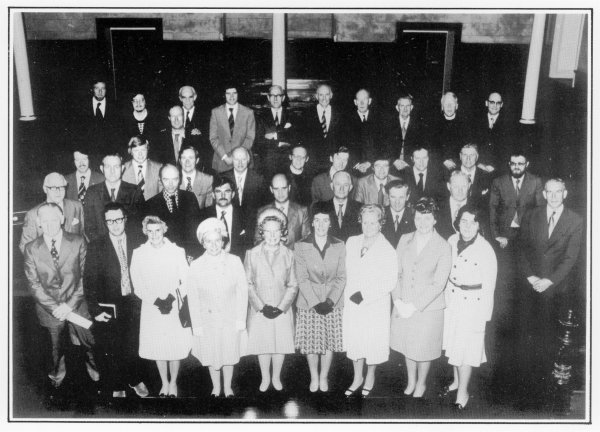 |
|
1975 Session
|
|
Back Row (left to right) |
|
W. Hodkinson, Rev. L. Farm
(Assistant), A. J. Beatty, W. C. McClenahan, R. W. C.
Kirkwood, |
|
H. S. Eaton, N. G. White, T.
Latimer, W. J. Cowan, Very Rev. Dr. Wm, Boyd, V. Boyd. |
|
Third Row |
|
W. A. Mcllmoyle, R. M. S. McCall,
E Bell, J. L. Boyle, Rev. R. J. G. Gray, I. Rutledge, |
|
I. Glasgow, C. W. Suffern, W.
G. Rosbotham, R. Mulholland. |
|
Second Row |
|
W. l. Crarg, D. L. Morrison, W.
McCrory, J. Hasley, N. C. Crossley, W Johnston, R. Davidson, |
|
W. A. McNeill, J. W. Russell. |
|
Front Row |
|
E. McClenahan, T. Kinkead, Mrs. E
P. Crossley, Miss M. E. Kennedy, Mrs. M. Latfmer, |
|
Miss E. Hunter, Mrs. N. Boyle,
Mrs. L. McKinney, Miss S. Boyd. |
|
Other members (not in photo) |
|
A. Martin, E. McClure, R. F.
McNeight. |
|
Photo: R. A. Gray |
The Windows Restored
You will have read in earlier pages of the sight which met the eyes of
those who entered the church immediately following the explosion and of
the work which resulted.
It is so easy to say as I did in the introduction to this volume that
"the windows were restored to their former glory". I suggest that few who
were not directly involved can begin to imagine what then faced Mrs. Norah
Boyle as Convenor of the Church Property Committee and her Committee
members, whose task it was to organise the re-construction of the damage
to the church and to our windows. The repair to the organ loft, the roof,
the pews and all the general re-decoration required was straightforward
when compared with the work of restoring our windows.
Let your imagination run riot and picture if you will seventeen large
partially completed jig-saw puzzles, some more complete than others, many
pieces missing, some broken into smaller fragments with all the remaining
pieces mixed together in several boxes and you will have some idea of the
work which lay ahead. Initially, even to the most optimistic, it must have
seemed that the work could never be completed. Those who thought that way
had not reckoned with the indomitable spirit and indefatigable energy
resources of the Property Committee. There were the inevitable inspections
by those responsible for bomb damage claims, insurance policies to be
checked, assessors to be met, architects to be consulted, artists in
stained glass to be visited, quotations to be obtained and numerous
Committee meetings to be organised and attended.
Having reached that stage the Committee was only approaching the
starting line. Month followed month, the seasons changed and, as is
inevitable with a project of this dimension, year followed year. Still the
work carried on. The town was searched for photographs which might exist
of the windows before they were damaged - fortunately a keen amateur
photographer, Mr. H. A. Duff, Church Treasurer, was able to produce six
excellent colour photographs and there also came to light a detailed
colour drawing of the Girls' Brigade window which had been produced by
Miss Tina Lindsay for a G.B. project some years earlier.
More meetings followed and the Property Committee were relieved to find
that Mr. Harry Eaton, Convenor of the Finance Committee, had taken some of
the weight off their backs by accepting the responsibility for negotiating
the bomb-damage claim, ultimately brought to a conclusion in September 198
7. Much help was given to Mr. Eaton by Mr. Norman White, our Clerk of
Session, himself a qualified accountant, and by Mr. Jimmy Lynn, another
accountant, who during the restoration period assumed the mantle of
Treasurer to the church.

During the early part of the process Mr. E. Bell, Member of Committee,
gave freely of his architectural expertise until he was appointed the
official church architect by the Congregational Committee when
professional ethics demanded that he could not sit on both sides of the
fence.
Having brought the possible restorers to a short list, churches were
visited to inspect the quality of their previous work, drawings produced,
costings given and only then after much consideration was the artist and
restorer chosen.
How wise the choice of Mr. James Watson of Belfast was is evidenced by
the windows as they now appear. Look at them, as I so often do, and it is
difficult, if not nigh impossible, to distinguish between the old and the
new- that in itself is sufficient comment on the Committee's choice.
The installation of the first restored window on 7th September, 1983
must have brought a joy to the hearts of those concerned which could only
be exceeded as one by one the windows re-appeared until all were back in
their proper setting- six long years of hard work completed and some
�40,000 spent! Those are the hard facts; how does one begin to estimate
the amount of energy and time expended by those involved?
The dedication and faith of the Committee was no doubt transmitted to
others of the congregation for there soon followed the offers of new
windows; one by the Beatty family in commemoration of Mr. Jim Beatty, a
long-time stalwart of the church and one to commemorate the Diamond
jubilee of the church's Scout Group, presented by past and present members
of the group.
The Resurrection window seemed to be the climax of the whole task yet
even the poignant installation of this window was still not the end. Mrs.
Norah Boyle presented a further window and two were presented by Mrs.
Stella McClenahan in memory of her parents. These last three windows can
be seen in the gallery vestibule.
The six additional windows have greatly added to the beauty of our
church; the Resurrection window particularly having given us all much food
for thought since its installation.
As far as the restoration of the damaged windows is concerned no
greater tribute can be paid to Mrs. Boyle, her Committee and Mr. James
Watson than to re-use Ivan Craig's words with reference now to all the
windows, old and new, "A joy and inspiration to all who behold them."
Wm. Richer
Property Committee Members August 1981
Mrs. Norah Boyle, Convenor J. Beatty E. Bell I. Bell R. Brown N.
Collins R. Davidson W. Hodkinson D. Morrison Mrs. E McCrory J Russell J
Starritt

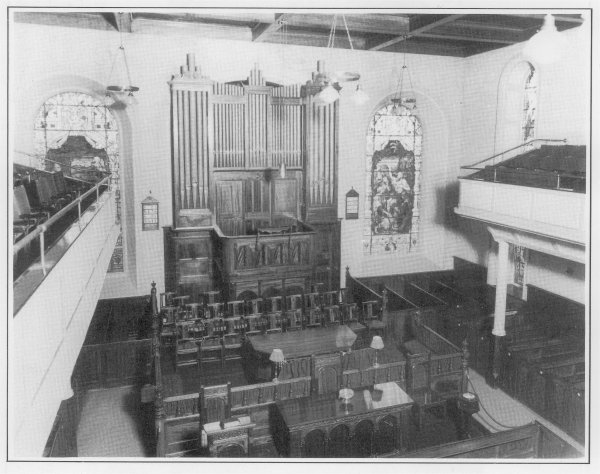 |
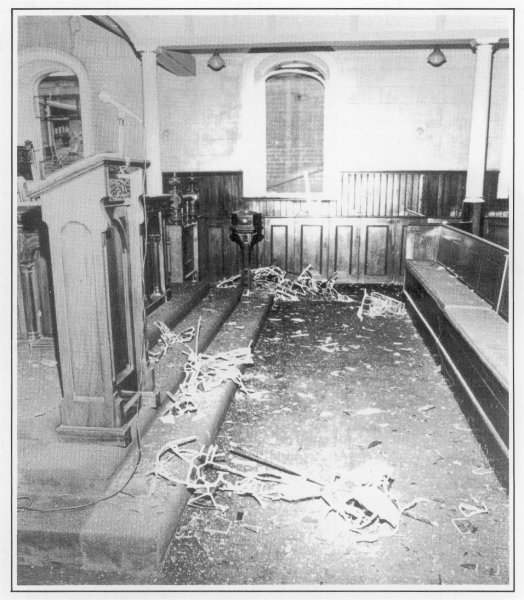 |
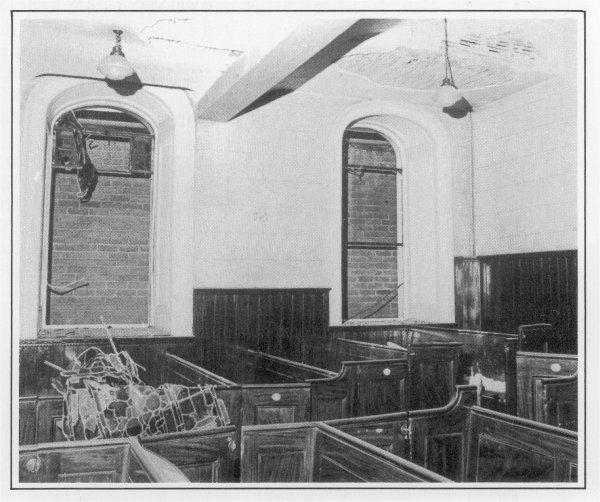 |
|
Interior 1968 |
Damage to Church interior and windows |
The Musgrave Window
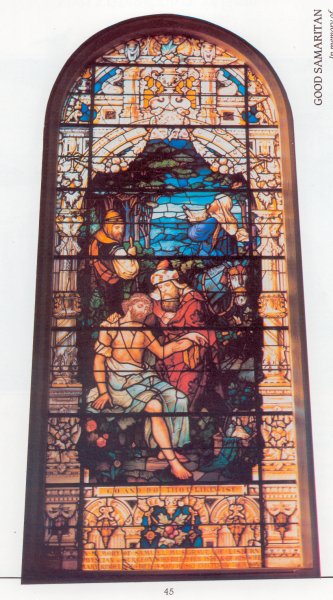 During the late eighteenth and early nineteenth centuries one of the
leading physicians and surgeons in the town of Lisburn was Dr. Samuel Musgrave who had his residence and surgery at the Corner of Castle Street
and Railway Street on the site of the premises now occupied by Messrs.
Alexander Boyd Ltd. During the late eighteenth and early nineteenth centuries one of the
leading physicians and surgeons in the town of Lisburn was Dr. Samuel Musgrave who had his residence and surgery at the Corner of Castle Street
and Railway Street on the site of the premises now occupied by Messrs.
Alexander Boyd Ltd.
Dr. Musgrave was a man of great character, held in the highest regard
as a good friend, and of the kindest disposition in his ministrations to
the sick. A man of resolution he, like so many Presbyterians at that time,
is reputed to have sympathised with the United Irishmen in their peaceful
but not their militant efforts to achieve their political ambitions to
such an extent that for a time during the 1790's he was held in custody at
Dublin Castle.
He married Miss Mary Riddel who was a member of a family outstanding in
the commercial activities of the still small neighbouring town of Belfast
in those days, and they were blessed with a family destined to occupy a
prominent place in their professional and business callings. Samuel
succeeded his father in medical practice in Lisburn, and Henry, together
with Edgar, soon made their mark with distinction and success in
industrial and business ventures in Belfast.
These sons of Fist Lisburn prospered greatly and in so doing showed
their sterling character through the many benefactions with which they
endowed the city of Belfast. It was through them that such institutions as
the Musgrave Clinic, Musgrave Park and Riddel Hall were established.
Although the family had left the town when the late Rev. J. J. C.
Breakey, B.A., came in 1886, he soon became aware of the affection held by
Henry and Edgar Musgrave for their native town, and in particular for
their church. Mr. Breakey was indefatigable in his efforts to press on
with the improvement of the interior of the church,, his main objective
then being to have stained-glass windows put in, and in guiding the
thoughts of those he considered had reason to endow the church in this way
his persuasions invariably met with the desired result. So it was that in
1907 the Musgrave window was installed. Since then it has been an
inspiration and delight to succeeding worshippers in First Lisburn.

Depicted in the window is the story of the Good Samaritan in which, in
the calmness of the church, all who regard it are reminded of the silent
sermon contained therein - Luke 10:29-37 - with the final exhortation -
"Go and do thou likewise". Apart from this, one can sense the
appropriateness of the subject as the memorial for Dr. Samuel Musgrave in
the healing ministrations of the Samaritan, and the completeness with
which the man travelling from Jerusalem was cared for to the extent of
providing for his welfare until fully recovered.
In the fullness of years, as applied to the Musgrave brothers at that
time, by their action and choice of content they have left an insight into
the influence upon their characters derived from their parents, which is a
reminder to all of us of our responsibilities in this connection.
The window was designed and made by Messrs. Meyer & Co. of London and
Munich and was supplied at a cost of �125. During the 1939-45 war it was
Ivan Craig removed as a precaution in case of air-raid damage and
stored in the country. On
Extracted from First Lisburn the cessation of hostilities it was
re-assembled. It is considered to be a most
Magazine Spring 1965 excellent example of stained-glass design and
craftsmanship.

First Lisburn Girls' Brigade
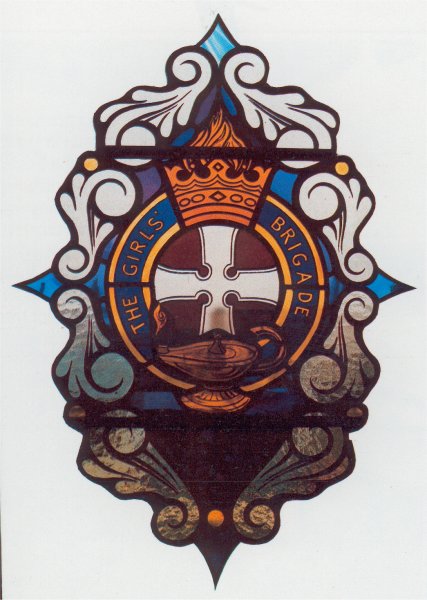 Having previously been Captain of 1st Company Rutland Square Girls'
Brigade in Dublin, Mrs. K. P. Tweed energetically pursued the idea of
forming a Brigade Company in First Lisburn. After much hard work, keenly
encouraged by the then minister, the Rev. D. Hay, a Having previously been Captain of 1st Company Rutland Square Girls'
Brigade in Dublin, Mrs. K. P. Tweed energetically pursued the idea of
forming a Brigade Company in First Lisburn. After much hard work, keenly
encouraged by the then minister, the Rev. D. Hay, a
Company was formed and sixty members were officially enrolled on 8th
November 1942.
It was considered in 1944 that the Company had made sufficient progress
to feel confident about entering teams in the National P.T. competition
held that year in Dublin. This confidence was duly justified when the
Associate Team gained first prize and the junior team fourth. The first
N.I. Battalion P.T. Competition was held in March 194 7 and later that
same year the Co. contributed four items to the annual display of the
District Uniformed Youth Organisations of which Miss M. Kennedy was
Secretary.
A milestone in our then short history was reached with the dedication
of our Colours at an Enrolment Service conducted by Dr. Hay in December
1949 - the first Co. in the Province
to achieve such distinction.
It was with great joy that in 1950 we welcomed the Rev. W. Boyd and
Mrs. Boyd to our
Co. in
Chaplain and
President respectively. By our tenth birthday, in 1952, we were the
largest
Co. in
Ireland with 160 members. To mark our birthday our
Founder, Mrs. Tweed, presented special awards to ten Founder members.
Our Co-Founder Dr. Hay, after many years of ill health, passed away in
1953, his passing being deeply regretted by all those who had been
associated with him. We had lost not only our past Chaplain but a very
good friend.
In 1956 the Co. created a record by "sweeping the board" in the
Battalion competitions taking first place in every section and winning all
the Cups. We celebrated the Girls' Brigade fiftieth birthday in Ireland in
1958 by presenting to the church a suitably inscribed table for use in the
vestibule. Five years later we celebrated our own twenty-first birthday,
now with 215 members.
1967, our Silver jubilee year, was marked by having installed in the
church a stained glass window, part of which was a representation of our
badge.
The 1970's were again eventful years with the retirement of the Very
Rev. Dr. W. Boyd and Mrs. Boyd. An association of some twenty-two years
had ended: both had been a great asset to us and Dr. Boyd had served the
entire Movement well as Chairman of the Lisburn Area Executive Committee
and later as Chairman of the N.I. Regional Board.
In 19 77, after almost thirty years as Captain, Miss Kennedy decided
she also should retire. Her years of loyalty, dedication and enthusiasm
which had taken her to many International gatherings was recognised by her
being awarded the M.B.E. for her services to the Girls' Brigade - a richly
deserved honour.
Further success too was achieved in 1979 when Gail Creighton and
Valerie Bird gained their international Award, the Brigade's highest
award. In 1985 four further members, Mandy Walker, Sharon Bothwell, Elaine
McCallum and Gillian McCallum also received their International Award.
More important than these achievements is the manner in which the Co.
upheld the old motto of "Onward and Upward" and will continue to uphold
the aims of the new MayArmstrong motto "To Seek, Serve and Follow Christ".

The Barbour Window
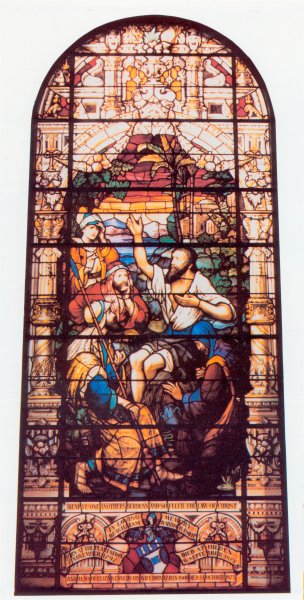 This magnificent stained-glass window, which is located to the west of
the pulpit, was installed in 1907 in memory of William Barbour of Hilden,
and his wife, Eliza Kennedy. It was donated by their distinguished
grandson, Sir Milne Barbour, in association with his mother, Mrs. j. D.
Barbour. This magnificent stained-glass window, which is located to the west of
the pulpit, was installed in 1907 in memory of William Barbour of Hilden,
and his wife, Eliza Kennedy. It was donated by their distinguished
grandson, Sir Milne Barbour, in association with his mother, Mrs. j. D.
Barbour.
It was in the year 1784 that John Barbour of Paisley came to Ulster and
settled at Plantation, Lisburn, where he established a linen mill, an
event which has for almost 200 years had such a tremendous impact upon the
economic well-being of the town and district. Subsequently he became a
member of this congregation in which his family was brought up. His son,
William, was born at Plantation on 7th November 1792, and at the age of 29
years became an Elder during the ministry of the Rev. Andrew Craig
(17821824). Co-founder with his brother of the Linen Thread Mills at Hilden, he was already a leading industrialist.
In 1824 he headed a deputation to the Presbytery of Bangor to support a
call to the Rev. James Morgan of Carlow, in succession to Mr. Craig who
had then retired, thereby bringing to the congregation, for a brief time,
a preacher who, in later years, became an outstanding personality in the
Presbyterian Church in Ireland, and a distinguished Moderator (1846-47) of
the recently-formed General Assembly. As Clerk of Session, Mr. Barbour was
outstanding. In the Session Minute Books he has left recordings which, for
clarity and penmanship, are a delight to read. His business activities
were pressing, making it necessary for him to withdraw from the positions
of Session Clerk and Elder in 1856. He continued as an active member of
the congregation and there is evidence that, although not holding office,
he continued to exercise a considerable influence in church affairs.
The content of the window depicts job in his time of affliction with
his friends, Eliphaz the Temanite, Bildad the Shuhite and Zophar the
Naamathite. In contrast to the garments on job, the robes worn by his
three friends present a richness and variety of colour which are quite
exceptional. Of particular note is the expressive looks on the faces of
the four men and the fine delineation of the hands.
The text, � Bear ye one another's burdens, and so fulfil the law of
Christ" (Galations 6 : 2), reminds all of us, who regard this window, of
one of our cardinal duties as practicing Christians.
Ivan Craig
Extract from First Lisburn Church Magazine, Winter 1966

Scouting in Lisburn
A meeting in the kitchen of Mr. R. Bell's home in Railway Street with
Mr. E. Bell and the Watson brothers led to the formation of the 63rd
Belfast Scout Group on September 24th 1924 under the leadership of Mr.
Kelly, later to
be replaced by Mr. R. (Skipper) Thompson who led the Group for some
fourteen years.
During his leadership, in 1932 a Wolf Cub Pack was formed with Jim Duff
as leader. Jim and his brother Harry had been early members of the scouts,
a family tradition carried on by their sister Norah (Mrs. J. L. Boyle) who
became Cubmaster
in 1936 and continued as such until 1945.
Perhaps the most important change during "skipper" Thompson's period
was when the Lisburn District Association was formed in 1934 and the group
changed to First Lisburn Scout Group, a title it has been proud to hold
ever since.
1942 was a year of many changes; Houghton Auld became leader, the blue
scarf was changed to a brown one and an enthusiastic pioneer patrol was
formed. With three King's Scouts; David Patterson, Tom McKinstry and Joe
White as founder members it was bound to succeed, as it did, becoming the
senior scout patrol of the Group.
This led in turn to the formation of the Rover Crew of which David
Morrison, at present an Elder of First Lisburn, was a member. David has
still his deep interest in Scouting giving sterling service to both the
Group and District committees.
Our youngest section, the Beavers, was formed in 1969 under the
enthusiastic leadership of Mrs. J. Watson. It, like the scouts and cubs,
has flourished ever since. During its history many members of the group
have been honoured with various Scout awards:- Medals of Merit from the
Chief Scout to Harry Gray, Brian Patterson and Mrs. Kathleen Crothers; the
Cornwall certificate for bravery during adversity to cub John Caldwell;
Queen's Scout awards to Bill McCrory, eventually to become G.S.L. , and
Stephen Irvine. Many others have received Chief Scout Awards and the
Gilwell Wood Badge.
Throughout all the years Scouting activities have continued; local
camps, international camps, the jubilee jamboree and all those other
indoor and outdoor activities too numerous to mention.
Our fiftieth anniversary in 1974 was celebrated in typical scout
fashion with a camping and sport display at Corries Glen, kindly loaned to
the group for many years by the Suffern family, Clemence and Hilda having
played an active part as leaders in our group.
In 1984 our Diamond jubilee was celebrated in memorable style. A
"Scout" stained glass window was presented to the church as a gift by past
and present members and at an unforgettable Service the Chief
Commissioner, Mr. Clifford Boyd, presented the group with its new
scarf-the old brown one to recall past years with a gold border to signify
the new.
The list of leaders and lay members who have encouraged and assisted
the group in its 64 years' existence is too vast to name them
individually. We thank them all for the legacy of scouting left to the
current leaders.
This legacy is in good hands; Morris Wilson, assisted by Len and Tom
Wilson, runs a strong scout troop, the cub pack is as keen and
enthusiastic as ever under the leadership of Mrs. Irene Richer assisted by
Mrs. Margaret Sones and the Beaver Colony actively continues under the
guidance of Mrs. Ruth Mulholland, Mrs. Elaine McCall and Jeremy Gray.
We eagerly look forward to playing our part in First Lisburn's
Tercentenary celebrations.
"History of Scouting" written by BRIAN PATTERSON

The Scout Window
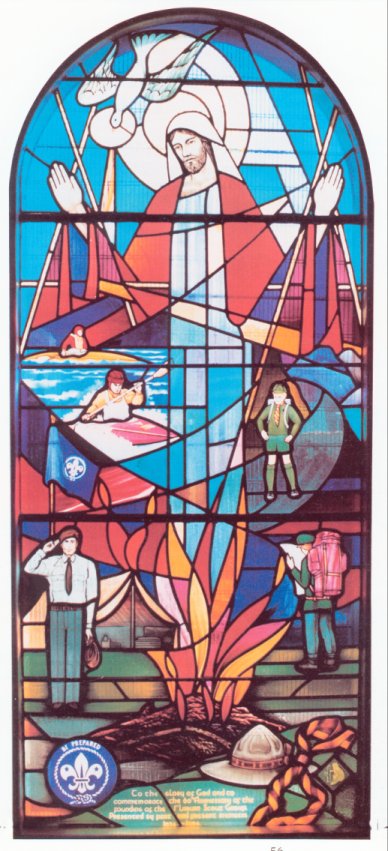 This window was the gift of the Church Scout Group to commemorate the
60th Anniversary of Scouting in First Lisburn. This window was the gift of the Church Scout Group to commemorate the
60th Anniversary of Scouting in First Lisburn.
The overall theme of the window is the interlinking of the activities
of Scouting and the Spirit of Christ as embodied in the Scout Promise,
which requires each member to do his duty to God.
The window suggests a "Path of Life" progressing upwards. On the left
is the World Friendship Badge, signifying the universal spirit of
Scouting. In the right corner is the original style of hat, reflecting the
founding of the movement by Lord Robert Badgn-Powell, symbolic of the
past.
In contrast, the Beaver Badge represents the youngest section of
together with the new Group Scarf, symbolising the present. The Scout
Motto "Be Prepared" is also depicted.
A number of figures participating in various activities represent
sections of the movement at different stages along life's journey. The Cub
Scout in uniform, carrying a rucksack, is setting out; while Scouts, map
reading and hiking, and Venture Scouts, canoeing, symbolise finding the
way. The saluting figure shows Leadership, guiding the younger members.
All these figures are set in scenes depicting the outdoor aspects of
Scouting.
The flames of the camp fire in turn symbolise the Fire of Life, and the
Holy Spirit in life's ordinary activities. The flames leading upwards
towards the Dove of Peace remind us of the story of Christ's Baptism.
Central to all the scenes and symbols is the figure of Christ dressed
in the Ruby Robes of Kingship with hands raised in blessing. The angular
shapes around the hands, linked to represent a bridge of the type often
constructed by Scouts in pioneering projects, together with the suggestion
of a cross-beam, symbolise Christ's supreme sacrifice on the Cross.
The window thus portrays the Risen Christ meeting Scouts of all ages
through the Scout movement and its activities.

|